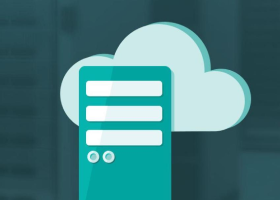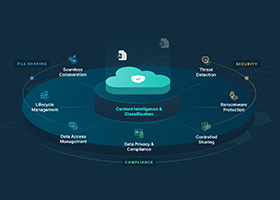File Sharing
File sharing is the practice of granting one or more users access to digital assets. A single document or multiple folders can be made available for viewing, downloading, or editing. File sharing offers a more secure alternative to emailing files and facilitates potential collaboration across a broadly distributed group.

With most file sharing, permissions are established to restrict access and define what can be done with the accessed assets. How files are shared depends on users’ environments and the types of data involved.
File sharing can be limited to inside an organization, using private networks, or opened up to allow anyone to participate using public networks. A number of tools and services are available to support file sharing internally and externally.
Key Features of File Sharing Software
- Dashboards
Functions as the control center of all file sharing activities, including permissions and monitoring - Data recovery
Addresses the common incidence of accidental file deletion and supports version control and file restoration - Data storage
Provides space for users to store excess information or make it readily available for file sharing - File transmission
Allows data to be transferred over digital communication channels—either a point-to-point transmission or a point-to-multipoint transfer - File version history
Keeps track of all versions of files being exchanged, copies of every version of files being collaborated upon, and older and deleted files - Granular access
Provides user protection control by determining the access levels of users to ensure that only those with the authorization are allowed to access certain files - Password protection
Enforces strong password-protection controls to ensure data security and privacy - Third-party integrations
Integrates with other applications to ensure productivity and efficiency
Types of File Sharing
File sharing software or services facilitate the sending and receiving of files, as well as collaboration among users via the Internet or a local network. Following are examples of file sharing solutions.
Cloud-Based
File sharing with cloud-based applications enables users to send files, create folders, and collaborate anytime, from anywhere, with an internet connection. In addition, files stored in the cloud can be synchronized across multiple devices.
File Transfer Protocol Programs (FTP)
FTP is an older file sharing system that’s used to access or edit files among a set number of users with a password. It is considered to be an insecure file sharing system that, in most cases, should be decommissioned and replaced with a more secure solution.
Peer-to-Peer Networks (P2P)
With P2P file sharing, systems can communicate directly without a centralized server. Files are shared from one user’s computer to another’s, who can make the file available to other users (“peers”).
System-Native
System-native file sharing utilizes tools that are built into an operating system. Users with the same operating system, on the same network, can use those tools for file sharing.
How Files and Folders are Shared
How Cloud-Based File Sharing Works
With cloud-based file sharing, files and folders are uploaded using the service’s control panel. Then, a unique URL is created that links to the location of the folder or files. The URL can be passed along to authorized users to provide role-based access (e.g., view, download, edit, share).
How File Transfer Protocol Programs (FTP) Work
FTP requires a TCP/IP network and one or more FTP clients to function. The FTP client acts as the communication agent to interact with the server and download or upload files.
How Peer-to-Peer File Sharing (P2P) Works
P2P file sharing programs allow computers to download files and make them available to other users on the network. These users can define the drives and folders from which files can be shared. Other users on the network can download and view files stored in these designated areas.
How System-Native File Sharing Works
System-native file sharing operates as a native function of an operating system. A built-in capability, system-native file sharing allows access across computers with the same operating system, typically inside a local network.
How to Choose File Sharing Software
Before starting evaluations to choose file sharing software, some preparation can make the process faster and more precise.
- Establish Requirements
Start by identifying primary and outlier use cases for file sharing. Then, create a list of must-have features and the functionality to support these.
Consider additional functionality that could extend or enhance the use of file sharing. For instance, collaboration might be critical, or it could be a nice-to-have feature that would not be used very much, if at all. - Take Advantage of Free Trials
There is no better way to understand how something works than to use it. Trials also provide an opportunity to get input from users. Also, trials sometimes reveal requirements that may have been missed. - Profile Users
As with any tool, there will be a variety of user types across use cases. It is essential to identify not just who will be using the file sharing system, but at what level—basic user or power user.
Also, how users will engage with the system will impact the type of file sharing system needed. Understanding user types will also help hone in on particular functionality that may or may not be a mandatory requirement.
Each organization will have its own set of requirements, but the following are a few that should not be overlooked during the file sharing software selection process:
- Compatibility
- Dashboard tools
- Industry certifications
- Price
- Process automation capabilities
- Reporting
- Storage
- Support
Security is one of the most important factors to consider when evaluating file sharing systems. Within the security category, specific file sharing functionalities to review include:
- Ransomware detection
- Suspicious log-In detection
- Insider threat protection
- Data encryption
- Permission settings
- Password protection
- Authentication
- Watermarking
- Behavior detection
- Virus scanning
- Data loss prevention (DLP)
- Advanced logging
File Sharing Risks
Most file sharing risks are related to individuals creating personal accounts:
- Increased instances of files being shared publicly
- Lack of centralized control over data
- Limited to no visibility into data flows
- Limited network / bandwidth requirements
- Increased vulnerability to malware
- Reduced access to technical expertise
File Sharing Benefits
- Auditability
- Improved access control
- Better organized and maintained files and folders
- Centralized file systems
- Compliance improvements
- Cost savings
- Data loss prevention
- Elimination of multiple file versions
- Enhanced security and governance
- Expanded collaboration opportunities
- Mobile-friendly options
- Time savings
- Scalability
- Simplified administration
- Social integration
Default to Secure File Sharing
Regardless of which file sharing tool best suits an organization’s needs, attention must be paid to security. While file sharing is vitally important for most organizations, it can also create a gaping hole in security systems. Always take time to thoroughly evaluate the security protocols and confirm that they are robust enough to protect the organization's data and will not jeopardize the security of other systems.
Egnyte has experts ready to answer your questions. For more than a decade, Egnyte has helped more than 16,000 customers with millions of customers worldwide.
Last Updated: 4th August, 2021



